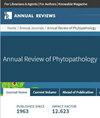十年解码:间谍和黑客在TAL效应研究的历史。
IF 9.1
1区 农林科学
Q1 PLANT SCIENCES
引用次数: 41
摘要
来自黄单胞菌属(Xanthomonas)的转录激活因子样效应物(Transcription activator-like effector, TALEs)是一种具有直接结合植物寄主基因启动子诱导其表达能力的蛋白质,这通常有助于细菌定植。打个比方,故事扮演间谍的角色,伪装成高级平民(转录因子)潜入植物,诱骗植物激活允许入侵的弱点。目前对“故事”运作方式的了解使研究人员能够预测它们的活动(反间谍)并利用它们的功能,设计它们来执行我们的命令(满洲特工)。这是可能的,特别是由于发现了它们的DNA结合机制,它遵循特定的氨基酸-DNA对应(TALE代码)。在这里,我们回顾了研究人员如何发现这些蛋白质的工作方式的历史,以及自发现密码以来的十年里发生了什么变化。阅读这篇评论的推荐音乐可以在补充材料中找到。《植物病理学年度评论》第57卷的最终在线出版日期预计为2019年8月26日。修订后的估计数请参阅http://www.annualreviews.org/page/journal/pubdates。本文章由计算机程序翻译,如有差异,请以英文原文为准。
A Decade Decoded: Spies and Hackers in the History of TAL Effectors Research.
Transcription activator-like effectors (TALEs) from the genus Xanthomonas are proteins with the remarkable ability to directly bind the promoters of genes in the plant host to induce their expression, which often helps bacterial colonization. Metaphorically, TALEs act as spies that infiltrate the plant disguised as high-ranking civilians (transcription factors) to trick the plant into activating weak points that allow an invasion. Current knowledge of how TALEs operate allows researchers to predict their activity (counterespionage) and exploit their function, engineering them to do our bidding (a Manchurian agent). This has been possible thanks particularly to the discovery of their DNA binding mechanism, which obeys specific amino acid-DNA correspondences (the TALE code). Here, we review the history of how researchers discovered the way these proteins work and what has changed in the ten years since the discovery of the code. Recommended music for reading this review can be found in the Supplemental Material. Expected final online publication date for the Annual Review of Phytopathology, Volume 57 is August 26, 2019. Please see http://www.annualreviews.org/page/journal/pubdates for revised estimates.
求助全文
通过发布文献求助,成功后即可免费获取论文全文。
去求助
来源期刊

Annual review of phytopathology
生物-植物科学
CiteScore
16.60
自引率
1.00%
发文量
19
期刊介绍:
The Annual Review of Phytopathology, established in 1963, covers major advancements in plant pathology, including plant disease diagnosis, pathogens, host-pathogen Interactions, epidemiology and ecology, breeding for resistance and plant disease management, and includes a special section on the development of concepts. The journal is now open access through Annual Reviews' Subscribe to Open program, with articles published under a CC BY license.
 求助内容:
求助内容: 应助结果提醒方式:
应助结果提醒方式:


